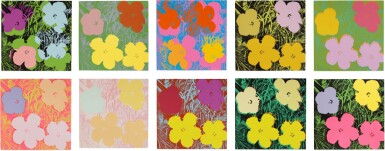
ANDY WARHOL | FLOWERS (F. & S. II.64-73)
Auction Closed
October 25, 12:01 AM GMT
Estimate
1,000,000 - 1,500,000 USD
Lot Details
Description
ANDY WARHOL
1928 - 1987
FLOWERS (F. & S. II.64-73)
The complete set of ten screenprints in colors, 1970, each signed in ball-point pen on the verso and stamp-numbered 27/250 (total edition includes 26 artist's proofs lettered A-Z), on wove paper, printed by Aetna Silkscreen Products, Inc., published by Factory Additions, New York (10 prints)
sheets: 914 by 914 mm 36 by 36 in
Leo Castelli, New York
Private Collection, Midwest
Private American Collection, acquired from the above in the late 1980s
While the Flowers today seem emblematic of Warhol iconography, they were at the time of inception a notable departure from the images of commercialism (Campbell’s Soup) or celebrity (Marilyn Monroe) for which the artist was becoming known. The composition originated as a photograph of hibiscus blossoms published in the 1964 issue of Modern Photography. Cropped, infused with startling colors defying those traditionally seen in nature and silkscreened repetitively first on canvases of varying size and then on paper, the Flowers took root as an enduring part of the Warhol oeuvre. The photographer Patricia Caulfield, upon discovering this unauthorized use of her image, sued Warhol in 1966, but one can only imagine Warhol’s delight in the matter. What could be a better instance of celebrating the banal than turning appropriation of a simplistic magazine photo into a lawsuit?
Fifty years after the publication of the portfolio, the Flowers hold a unique position in the canon of Warhol’s early prints. They do not illustrate a brand name, political figure or movie star. There is no cultural context beyond the image itself, and yet they are as recognizably Warhol as a Brillo box or a portrait of Mao Tse-tung. Ten prints with impulsive color combinations, exemplifying the artist’s affinity for repetition, the Flowers were bold and accessible - they made a statement without taking a side during the emotionally charged era in which they were born. Andy Warhol is an intrinsic figure in 20th Century culture and his Flowers exemplify the POP movement he championed.
